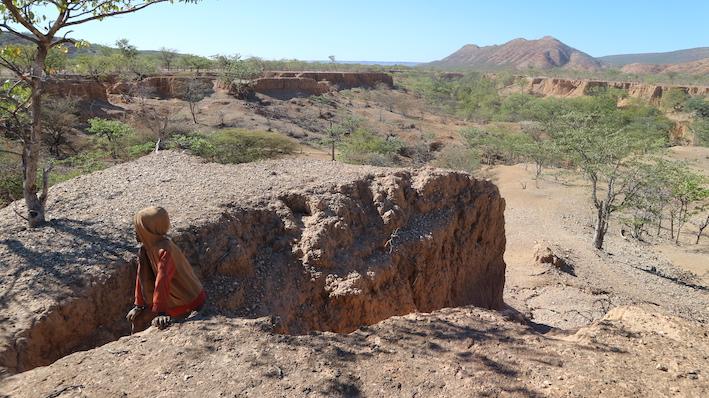Inhabitants of the Gully: a dispatch from the "Changing Landscapes, Changing Societies" project

This article is a dispatch from the "Changing landscapes, changing societies" project led by Miguel Vallejo Orti and collaborators from colleagues from the Namibia University of Science and Technology and Heidelberg University. Read more about the project HERE.
Opuwo, as a crossroad
Located in the Northwestern part of Namibia, the town of Opuwo is a melting pot of cultures, ethnicities, aesthetics, and languages. Its streets permit an encounter with women covered in red clay, elegant ladies dressed in Victorian costumes, semi-nomadic shepherds and countless youths’ groups chatting happily. The town has no restrictions for domestic animals roaming the streets effortlessly, wandering around comfortably but rather depicts a state of elation and safety, reviving memories in pioneer towns of the Yukon or the American West as portrayed in movies, with the initiatory chaos of a budding city.
Livelihoods under environmental pressure
Opuwo can be a windy place immersing itself in dust. The town is surrounded by a sea of hills and valleys sown with Himba and Herero traditional communities. In these settlements, barter is common hence small familiar villages form intertwined communities where everyone knows each other, and hierarchies and territorial powers are not written but are known and respected. As a practice, overgrazing is endemic, specifically that of goats as a primary livelihood for several families, as is the case with rain-fed crop farming. A large gully cuts the ground in one of the valleys extending to the south from Opuwo, creating a unique landscape. The water runoff causing erosion during intense rainy seasons, ripping the soil while conveying a substantial amount of sediment downstream. Resultantly, a huge crack forms reaching more than 150 meters wide, with multiple ramifications that each extends transversely to the mainstream. The residents of this land are accustomed to this changing canyon growing in depth and width each year, accelerating desertification, reducing grazing areas, and jeopardizing roads, stables, and households.
Human resilience and adaptation
For a geomorphologist or a human geographer, the town is a laboratory and perfectly illustrates the effects of climate change on livelihoods. On the flip side, not all the derived impacts are negative: the Gully, with an in-depth length of up to fifteen meters, provides unique shade in the region. At some points, it has reached underground reservoirs, supplying water by forming small water bodies and meeting sites for local shepherds. The Gully is a passage, a resting camp, and a playground for the neighboring children as they guard their grazing animals. The Gully accumulates humidity and forms a linear oasis filled by trees and bushes, greener than its adjacent semi-desert. As food storage for animals, it extends the grazing period during dry seasons enticing scattered goats in the maze of branches, the former susceptible to lose or theft, which would be unlikely in a flat landscape.
The future of the valley
Inhabitants from the Gully spark curiosity and wit. The vicinity is encompassed by rich traditional routines ranging from celebration dances, women pursuing daily chores, children as shepherds, and young men crossing the Gully to visit their families or cultivate their crops. They find amusement by conversing or fellowship with infrequent visitors despite their struggle to understand the foreign interest in their way of life or the relative importance given to the local landscape. When questioned about the Gully and its longevity, at best the elderly fear the consequences of erosion: causing wreckage to their homes and kraals, prompting relocation or even migration, as the land perpetually loses productivity. As an alternative, some residents aspire and pursue life in the city, selling crafts and taking photographs with tourists. This predicament poses a threat as preserving their identities and ancestral traditions has been and still is a priority for the Himba of Kaokoland.
Contact: morti@nust.na
This project is an ILMI Seed Grant 2020 Awardee. For more infomation about the projectes, see: http://ilmi.nust.na/seed-grants-2020-awardees
